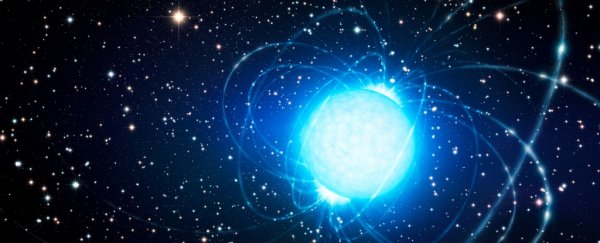A magnetar that recently erupted with a storm of activity may have given us a lead on the mystery of fast radio bursts (FRBs).
According to a new analysis of the magnetar XTE J1810-197, millisecond bursts of low-frequency radio waves sputtered out by the dead star show an unusual similarity to FRB signals. It's far from conclusive proof that the two phenomena are linked, but it's one of the most tantalising hints yet.
This claim is just one of several findings in a new paper, accepted into The Astrophysical Journal, and currently available on the pre-print resource arXiv. The research team behind this work has analysed the magnetar's low-frequency radio output using the second of just two outbursts we've ever caught from this source.
Magnetars are a particularly strange type of neutron star. Their magnetic fields are somehow insanely strong - around a quadrillion times stronger than Earth's own magnetic field. We don't know what processes produce these magnetic fields, but they're strong enough to make the space around them seriously screwy.
We haven't found many magnetars, as it's thought that this life stage for a star lasts a very short time in cosmic terms: just 10,000 years. Of those we have found, XTE J1810-197 is among the strangest of them all.
Located 10,000 light-years away in the constellation Sagittarius, it was the first of only four magnetars found to emit radio waves - but it only does so intermittently. It was crackling away in radio frequencies when it was discovered in 2003. Then, in 2008, it mysteriously went radio silent.
But December of last year, it flared to radio life again, and astrophysicists at the National Centre for Radio Astrophysics in India turned the Giant Metrewave Radio Telescope (GMRT) in to listen.
Their results, obtained mostly over four observation runs in the low-frequency 550 to 750 MHz range, revealed a rapid decrease in the radio flux density after the initial onset of the outburst. This was consistent with observations of the first outburst.
"Similar to the previous outburst, the 650MHz flux density decreased by a factor of about 5 or more in the first 20 to 30 days," the researchers write in their paper.
What seemed to particularly intrigue them, however, is the possible link to fast radio bursts, mysterious spikes in radio data that last just a few milliseconds, but with as much energy as over 500 million Suns. Most FRBs have not been detected repeating (which the magnetar bursts did), but there were striking similarities.
The team observed the magnetar emitting millisecond spikes of radio wave activity, with spectral structures that - just like FRBs - can't be explained by effects caused by their passage through the interstellar medium, the gas and dust between the stars.
"These structures might indicate a phenomenological link with the repeating fast radio bursts which also show interesting, more detailed frequency structures," the researchers wrote.
It's only a "maybe" at this point. There are also a couple of features that would need to be looked into.
Firstly, repeating FRBs often demonstrate a phenomenon known as frequency drift, where successive bursts drift downward in frequency like a sad trombone.
Due to their resolution and scattering at the frequency range they were observing, the researchers were unable to resolve any frequency drift in their data. That doesn't mean it wasn't there, but it would require a different dataset to try and find it.
Secondly, there's the question of signal strength. The magnetar's signal was an order of magnitude more powerful than the peak of repeating FRB 121102, but there's a catch - the FRB travelled from much, much farther away.
This implies the FRB's source would have to be around 100 billion times more luminous than the peak of XTE J1810-197's outburst as captured by the GMRT.
"Nevertheless," the researchers write, "the fact that the magnetar J1810−197 is only the third object after the repeating FRBs and the Crab pulsar which is found to exhibit frequency structures in its bursts, might provide a phenomenological link between the underlying emission mechanisms."
The research has been accepted into The Astrophysical Journal and is available on arXiv.
